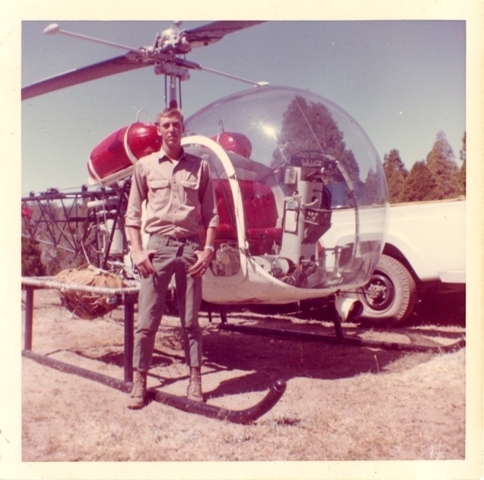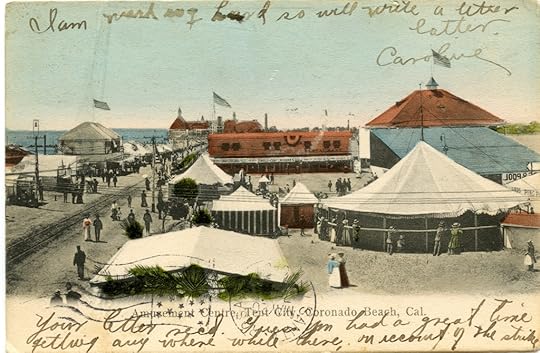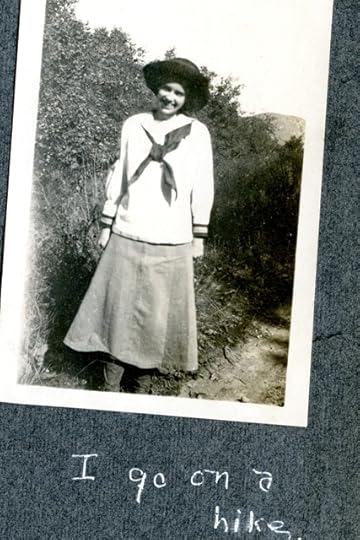Barbara Anne Waite's Blog, page 8
October 15, 2011
Historic Tent City, Coronado Island, San Diego
October 10, 2011
Fire Lookout Towers- Arizona and California
 When I met my husband 48 years ago he was a dashing young firefighter, part of a U.S. Forest Service Helitack crew on Palomar Mountain. I was a firefighter admirer! We just celebrated 44 years of marriage last month. Curt has served as a volunteer Fire lookout when we are in California. Now I have become a fire lookout fan. I recently became a volunteer forest fire lookout myself, and a member of the Forest Fire Lookout Association (FFLA). Twice a month Curt climbs the 68-foot tower of High Point lookout and watches all day for any signs of smoke to be reported. Soon they will add Boucher Hill Lookout (which is only thirty feet tall) and that sounds much more reasonable to me. So we became excited when we realized Elsie had written in 1915 about visiting two fire lookout sites in Arizona. The lookout tower on Bill Williams Mountain in Elsie's day was actually a tree with a platform on top for the Forest Service lookout to stand on. It was reached by a ladder made of pine poles. The photo I have shows a lookout ranger standing on a rustic platform with binoculars. The fire tower at the Grand Canyon, Hopi Point, was much more sophisticated. It, and two other fire towers at the Grand Canyon, was built by the U. S. Forest service before the Grand Canyon became a National Park. Photos of both of these towers, from the early 1900's, are in the book. Another picture I have included in Elsie is of her riding with a forest ranger and several other teachers.
When I met my husband 48 years ago he was a dashing young firefighter, part of a U.S. Forest Service Helitack crew on Palomar Mountain. I was a firefighter admirer! We just celebrated 44 years of marriage last month. Curt has served as a volunteer Fire lookout when we are in California. Now I have become a fire lookout fan. I recently became a volunteer forest fire lookout myself, and a member of the Forest Fire Lookout Association (FFLA). Twice a month Curt climbs the 68-foot tower of High Point lookout and watches all day for any signs of smoke to be reported. Soon they will add Boucher Hill Lookout (which is only thirty feet tall) and that sounds much more reasonable to me. So we became excited when we realized Elsie had written in 1915 about visiting two fire lookout sites in Arizona. The lookout tower on Bill Williams Mountain in Elsie's day was actually a tree with a platform on top for the Forest Service lookout to stand on. It was reached by a ladder made of pine poles. The photo I have shows a lookout ranger standing on a rustic platform with binoculars. The fire tower at the Grand Canyon, Hopi Point, was much more sophisticated. It, and two other fire towers at the Grand Canyon, was built by the U. S. Forest service before the Grand Canyon became a National Park. Photos of both of these towers, from the early 1900's, are in the book. Another picture I have included in Elsie is of her riding with a forest ranger and several other teachers.
September 2, 2011
Santa Fe Railroad Entertainment 1914-1916 Williams,Arizona
The early Arizona roads were rough. One of the folks I interviewed (in 1988) in Cornville recalled how their family traveled by horse and buggy to Jerome to buy groceries only a couple times per year. No GPS to take along for a ride to the grocery store in those days, instead they packed picks and dynamite in the wagon to repair the roads.
Williams, where Elsie taught after Cornville, was much more developed. The Santa Fe railroad line went directly through Williams. The town had several grocery stores. The Fray Marcos Hotel and the Harvey House restaurant were popular places with the Williams teachers in 1914-1916. Both of these were connected to the Santa Fe Railroad.
While doing research about the Santa Fe railroad the part I found most interesting was a service provided by the railroad that has now disappeared. Most of the small railroad towns had little entertainment. One article I read said that for every grocery store there were half a dozen saloons in most RR towns. In 1914, Williams had far more saloons (eight) than grocery stores (two). The railroad did not want their personnel operating trains after a night (or day) in a saloon, so the railroad took on the task of providing diversions for its employees. By 1915 The Santa Fe RR had developed 25 reading rooms along the line. But taking it a step further the Santa Fe offered free travel to performers who would provide a night's entertainment in the Santa Fe RR towns. Sometimes it was simply a Shakespearean actor but other times they would have a traveling orchestra complete with harp, violins, cello, drums and a piano. Free travel offered to entertainers drew performers from across Europe, Canada and the U.S.A.
The seating was reserved first for Santa Fe employees and then open to the public. Elsie frequently attended these free Santa Fe events. It appears it was not a poor financial choice for the railroad. Elsie often wrote that after the free Santa Fe the teachers stayed to have supper at the Harvey House Restaurant that was operated by the railroad.
Several times Elsie described these concerts or entertainments as, "not much good" or "poor Santa Fe tonight." But at other times she described them as excellent. The orchestras occasionally stayed to perform for a local dance. Something has been lost with the demise of travel by rail.
August 14, 2011
Eggs via the mail !
It would appear that the United States Postal Service system was quite efficient in 1913. Letters and packages were regularly sent back and forth between Elsie in rural Arizona and her family in California. Her letters home reveal some interesting insight into the U.S. postal system of nearly 100 years ago. In 1913 the mail traveled the same route Elsie took to reach Cornville. By rail from Southern California to Jerome, and then in canvas sacks by horseback or wagon to Cornville.
From Cornville Elsie wrote, "Mama I hate to ask for so many things, but feel as if we were out of the world here." She thanked her mother for mailing the pea soup! This was home-made and in a mason jar. Can you imagine today a jar of soup mailed from California to Arizona and arriving without incident? Rather amazing.
At Christmas Elsie thanked her family for mailing, fruitcake, cookies, candied cherries, raisins, dates and ginger.
She mentions going to the Post office to receive violets her father had mailed for her birthday. He also mailed her albacore tuna, probably smoked or home-canned.
Elsie raved about the sausage they had sent. They shared it with a teacher after he had ridden quite a few miles to visit and then stayed to supper and he commented that it was "…like finding a gold piece when you haven't seen one in 15 years!"
She mentions being delighted with bread her family had mailed. They also regularly mailed her eggs! It is hard to imagine the post office delivering eggs without breakage or spoiling.
During Elsie's time living in Williams she enjoyed the lovely pine trees and she wrote of mailing sprays of pine boughs to several friends in California.
My hat is off to the postal system of 1913.
August 6, 2011
The Middy blouse – a long-lived fashion
The Middy blouse – a long-lived fashion.
I have been looking at Elsie's Arizona pictures to choose the ones for the book. I love the Middy blouse she frequently wore. It seems it was her outdoor exercise wear. Horse back riding fashion included a divided skirt that Elsie said weighed close to thirty pounds, and a middy blouse. I can't imagine how difficult it must have been to wash a 30 pound skirt in the creek. I can hardly imagine slender Elsie who only weighed about 100 pounds having the strength to wring out by hand such a heavy skirt. But they often rode bareback and in the heat, so I'm sure the skirts would need washing quite often. I can't imagine anyone today choosing to wear a 30-pound divided skirt!
The middy blouse she frequently wore is still in fashion. In Japan and in Antigua it is often a school uniform. The middy blouse was actually introduced about 1910 as exercise wear, so I imagine Elsie was in the popular fashion of the day when she went riding in her middy. One photograph shows 5 girls looking like carbon copies – all astride horses wearing a middy top. Previously the sailor-top look was popular with children. Pictures of girls in summer camp "wear" show the girls all dressed in similar sailor-collar tops. It was probably called a "middy" after midshipmen. In one mail order catalog for 1916 the middy cost $1.00 and was very stylish. It seems they were traditionally white with blue scarf trim. One advertisement stated that the middy was originally designed after the blouses worn by "Uncle Sam's sailor boys." The dropped waist middy dress was brought back by Laura Ashley in the 1980s. I remember wearing one of those. Wish I had one of Elsie's Middies!
August 1, 2011
July 15, 2011
My favorite books about America's teachers
Books and Movies about teachers that I have loved:
I have always enjoyed books about teachers. Perhaps my favorite is Tisha, the true story of a 19 year old teacher in Alaska in the 1920's. It was exciting and enlightening. I enjoyed and learned much about rural teachers in The Thread That Runs so True. It is based upon the author's actual life as a 16 year old teacher in rural Kentucky in 1925. Christy was delightful and was based upon Catherine Marshall's mother's adventures as a 19 year-old teacher in the Appalachian mountains of NC. There must have been some interesting stories to tell of teachers on the early Western frontier as well. I read that between the years 1847-1858 over 600 young women answered the call to become teachers in one room school houses in America's rural frontier. I wonder how many of those girls recorded stories in a daily journal?
I loved the TV mini-series "Anne of Green Gables." When Lucy Maud Montgomery wrote the book it was set in a time period a few years before Elsie's adventure in Arizona. The TV mini series came out shortly before I began my research into Elsie's Arizona years. I read on-line that the date set for the second part of the series was supposed to be 1915. So I loved looking for similarities in the dress styles, in attitudes and in things like red-tin tobacco lunch boxes. I watched it over and over imagining what it must have been like to teach in a one-room rural school.
I have discovered that, at age 25, Elsie was older than many western teachers of that time who were teaching in their teens. Many states had such a desperate need for teachers in one-room schools that the qualifications were minimal. California was apparently unusual for that time period in their requirement of a 5th year of teacher's training before a teacher could qualify to teach.
Do you have a favorite "teacher"book?





